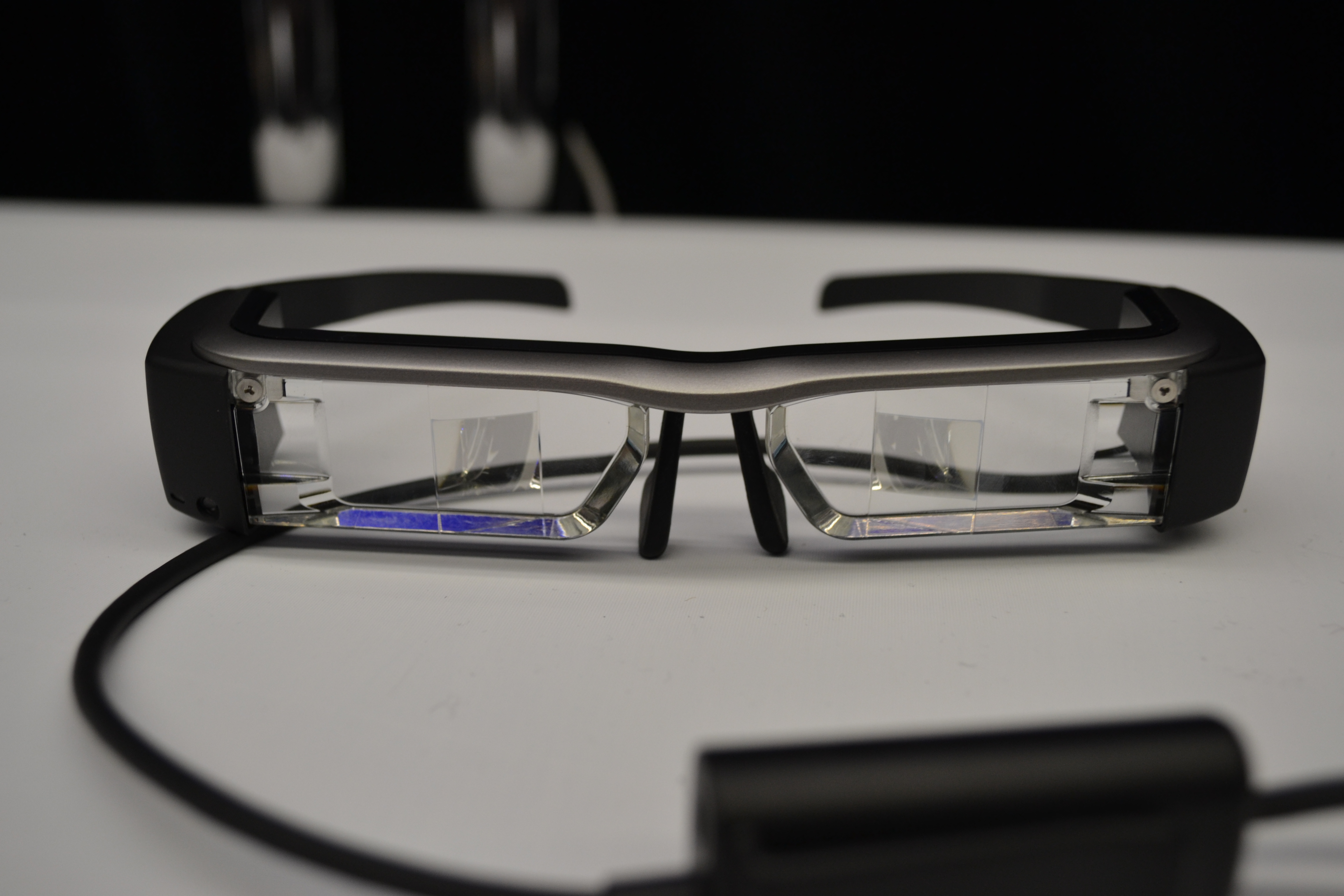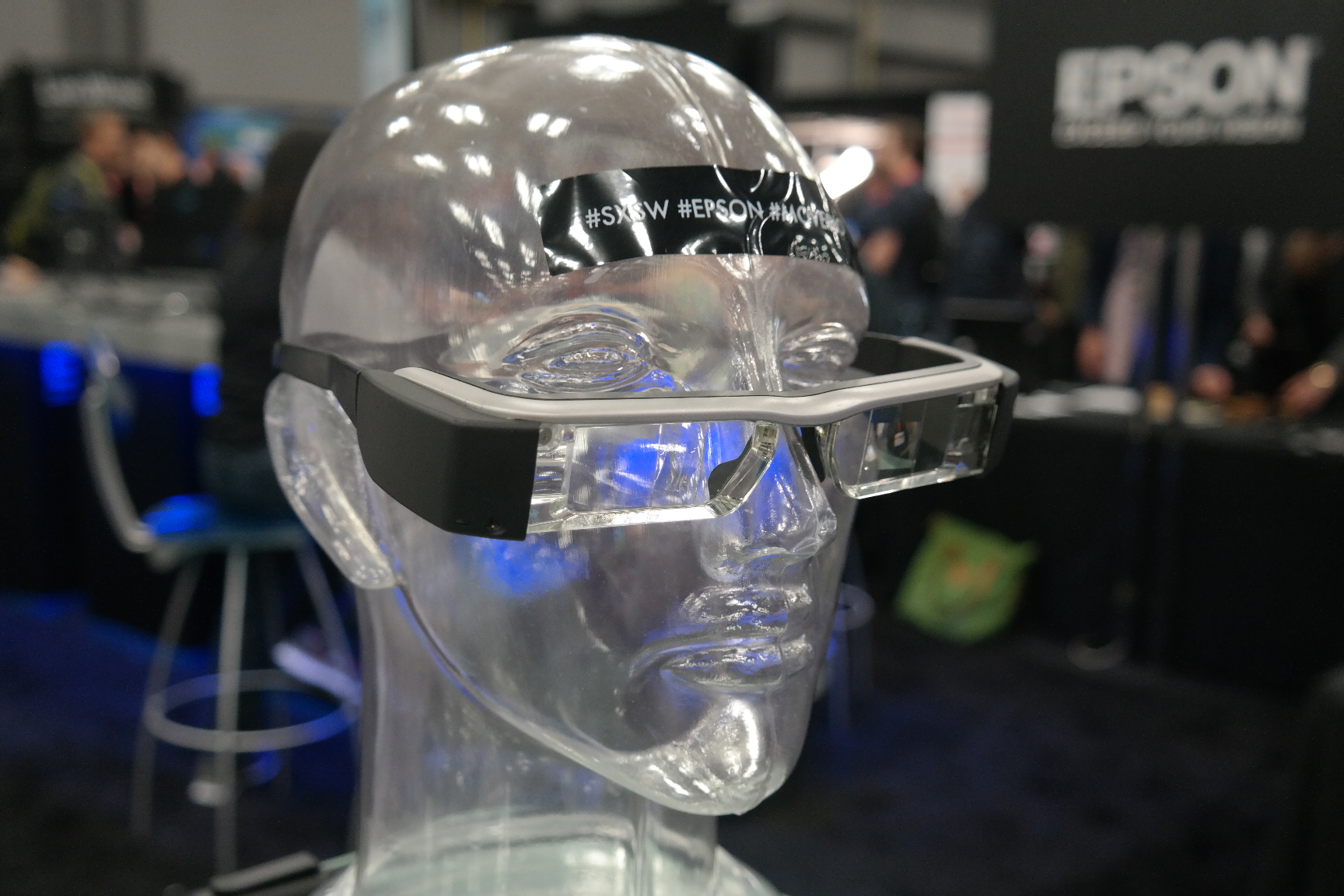The Past, Present, And Future Of VR And AR: The Pioneers Speak
Epson Moverio
You may know Epson for its printers and projectors, but the company has been hard at work on Moverio, its AR technology, for the past couple of years, first demonstrating the glasses at CES. These are binocular glasses, with a display resolution of 960x540, or QHD. Moverio can broadcast 3D content in your field of view (23 degrees). There is a front-facing VGA camera, made more as an image sensor to conserve battery life and keep the unit light. The glasses connect to a control unit that powers the displays. The control unit runs Android 4.0 (ICS), supports Wi-Fi and Bluetooth, includes a touchpad and a micro SD slot, and gets up to six hours in an always-on use case. The glasses include a gyro that polls at 60 FPS, a GPS, and there's an IMU sensor in the control unit.
Epson's Eric Mizufuka, Product Manager, New Markets, answered Tom's Hardware's questions.
| Optical | |
|---|---|
| LCD Driving Method | Poly-silicon TFT active matrix |
| LCD size | 0.42 inch wide panel (16:9) |
| LCD Pixel Number | 518,400 dots (960x540) x 3 |
| Field of View | Approx. 23 ° |
| Screen Size (Projected Distance) | 40 inches at 2.5 m - 320 inches at 20 m |
| Color Reproduction | 24 bit-color (16.77 million colors) |
| Refrech Rate | 60 Hz |
| Android Platform | |
| OS Type | Android 4.04 |
| OS Update | via network |
| Pre-installed Applications | SEViewer, Moverio Apps Market, Moverio Air, Moverio Mirror (for WiFi Miracast) |
| Sensors | |
| Camera | VGA |
| GPS | Yes, in Controller |
| Compass | Yes, in both Headset and Controller |
| Gyroscope | Yes, in both Headset and Controller |
| Accelerometer | Yes, in both Headset and Controller |
| Microphone | Yes |
| Connectivity | |
| Wireless LAN | IEEE 802.11b/g/n |
| Bluetooth | 3.0 |
| microUSB | USB 2.0 |
| CPU And Memory | |
| CPU | TI OMAP 4460 1.2 GHz Dual-core |
| RAM | 1 GB |
| Internal Memory | 8 GB |
| External Memory | Micro SD (max. 2 GB), MicroSDHC (max. 32 GB) |
| User Interface | |
| Function Key | Home, Menu, Back, Function (Brightness, 2D/3D), Volume (+/-), Power (lock), Reset |
| Touch pad Pointing method | Capacitive Multitouch |
| Supported File Formats | |
| Video | MP4 (MPEG4+AAC / Dolby Digital Plus), MPEG2 (H.264+AAC / Dolby Digital Plus) |
| Audio | AAC, MP3, WAV, Dolby Digital Plus |
| 3D supports | Side By Side |
| Sound Output | |
| Surround | Yes, Dolby Digital Plus |
| General | |
| Operating Temperature | 5 ° C - 35 ° C, 41 ° F - 95 ° F, 20 % - 80 % Humidity |
| Power Supply Voltage: AC adapter | 100 V - 240 V AC +/- 10%, 50 Hz/60 Hz, with Micro USB cable |
| Battery Life | 6 hrs (Video mode with Android at 25°) |
| Battery Type | Li-Polymer 2720 mAh |
| Dimensions: Head set | 170 mm x 185 mm x 32 mm (D x W x H) (without light shielding) |
| Dimensions: Controller | 120 mm x 55 mm x 19 mm (D x W x H) |
| Weight Headset | 88 g (without light Shielding / without harness) |
| Power Supply Voltage Controller | 5 V, 900 mA via micro USB terminal |
| Weight Controller | 124 g |
| What's in the box | AC adapter, Carrying Case, Ear Hook, Inner frame for optical lenses, Intraauricular earphone with microphone, Quick Setup Guide, Shade x2 (light and dark), USB cable, User Manual (CD-ROM) |
Tom's Hardware: Is your technology based on AR or VR, and why?
Epson: Epson’s Moverio technology is based on augmented reality (AR), because it’s a transparent display centered in the user’s field of view. Augmented reality is able to blend the real world with the digital world, while a VR user can only see digital content. Our Moverio smart glasses are also binocular so developers can render 3D overlays of digital information onto real world objects, opening up an unlimited number of compelling use cases for enterprises in healthcare, training, logistics and more, as well as for consumers.
Tom's Hardware: When will we see mass adoption of VR and AR technology (defined as more than one million customers)?
Epson: I think that we’ll see the adoption of VR happen first in the consumer space with mass adoption in the next year or two, while AR’s early big sales and adoption will be driven by the enterprise space. I believe AR mass consumer adoption will occur 1-2 years after VR reaches mass consumer adoption.
Tom's Hardware: What are the technical hurdles still standing in the way?
Get Tom's Hardware's best news and in-depth reviews, straight to your inbox.
Epson: For AR headsets form factor is important, including making the glasses smaller, lighter and less intrusive. The other technical hurdle is field of view. With a VR headset it is pretty easy to have a large field of view because you can use distortion optics and render an entire digital world, but with AR you need a smaller and lighter device since this is a headset that the user could be wearing on-the-go. Therefore, rendering a large field of view is a technical challenge for the smaller and lighter AR device.
Tom's Hardware: What are the non-technical hurdles standing in the way?
Epson: The non-technical hurdles are the social stigmas of wearing technology on your face. There is some negative feedback regarding certain consumer smart glasses, so I think that longer-term, consumers need to get more familiar with the technology in the workplace and through more purpose-built experiences.
Tom's Hardware: What steps are needed to remove those hurdles? What is your company doing specifically and technically to remove those hurdles?
Epson: Technically, to remove the hurdles, we’re investing heavily in miniaturizing the platform and making the glasses as small as possible. Our Moverio BT-200 smart glasses are down 60% in weight from our Moverio BT-100.
To combat the social stigma, we’re targeting very purpose-built applications and use cases like using the smart glasses in a museum or in the workplace where people actually know why you’re wearing the technology. This awareness and comfort will lead to greater adoption and acceptance of smart glasses.
Tom's Hardware: How will VR and AR change the gaming ecosystems in the future (PCs and components, consoles, controllers, and the games themselves)?
Epson: AR and VR are very processor-intensive – rendering digital content or recognizing anything in the user’s field of view requires a lot of processing power – so there is going to be a strong need for quick access to the cloud and intense vision recognition algorithms running in the background. I think this is really going to push the components industry, to keep up with the complex vision-recognition algorithms needed by augmented reality platforms.
Tom's Hardware: How will VR and AR change the world outside of gaming? Give us the most remarkable, life-changing examples you expect to happen.
Epson: In the near-term, the game-changing applications are in the workplace, providing a safer and more efficient work environment through the use of AR. Longer-term, I think providing real-time access to information anywhere will be a life-changing experience in how we interact and process the world around us.
Read more: Eyes-on Epson Moverio at CES 2014
-
icepick314 would Virtual Boy from Nintendo count as VR tech?Reply
it's missing in the article's timeline...
also an arcade game Time Traveler that had "holographic" screen... -
Cazalan I think they're wasting too much time on the motion capturing aspect. Just give me a headset that looks better than a 30" monitor and I'm sold.Reply -
Vlad Rose With the Virtual Boy, I would call it VR tech as it uses similar technology that used in the VR gear that is coming out. With Time Traveler and Holosseum, I would say no. What they used was a single 2D screen that was projected to a curved mirror to create a false reality of the image 'sticking out'. It is more comparable to 3D movies than Virtual Reality.Reply -
clonazepam The Vuzix seems pretty cool. We've already accepted bluetooth headsets and its a very similar look. I hope they all account for the fact that some people are right-handed and left-eye dominant or other way around, as well as color blind or red / green deficient.Reply
I think the Vuxio would be the most useful in everyday life, while obviously Oculus or Morpheus being the most fun. -
Shankovich Morpheus looks cool but it just can't compete with the rift when hooked up to the PS4; it just doesn't have the graphical power to run above 1080P games with acceptable level of detail, effects, etc. especially when the frame rate will need to be at 60fps or more to reduce nauseating effects. On PC, the rift has better sensors (geomagnetic) and is better able to take care of movement lag.Reply -
CaedenV @CazalanReply
Agreed. I am all for VR to hit when it is really ready, but until then I would be extremely happy with a high resolution headset to use as an immersive display. I don't want to have to crane my neck and change my body's orientation when gaming. I still want a keyboard/mouse or controller as input and be able to sit back on the couch and just play a game. I have a nice big yard to work on if I want something active to do... when I am gaming I want to get into it, but with the least amount of physical effort possible. -
Henderburn The VR timeline should include the release of "Snow Crash," the novel that inspired John Carmack and Michael Abrash to make Quake and build the foundations for VRReply -
WyomingKnott I'm still waiting for a decent eyeglass-size display so I can read a book while the dentist pokes at my teeth. Seriously, we don't have even the basic display element available commercially?Reply -
Cybolic Vuzix examples are probably the worst I've ever heard: "having a sales associate be able to answer your questions" and "see exactly where your veins are so they only stick you once with the needle to get the blood", yeah, they are supposed to already be able to do that without wearing special glasses; it's literally what they're being paid for.Reply


